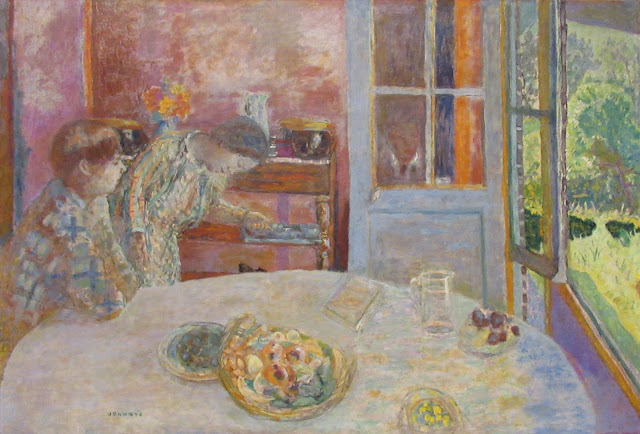Pierre Bonnard,
at Tate Modern.
The paintings of Pierre Bonnard create a remarkable sense of intimacy. Many of them allow glimpses into a private world, depicting the domestic life that Bonnard shared with this companion, Marthe de Meligny. This exhibition focuses on his mature work, as he developed a highly individual command of colour.
Man and Woman, 1900, (oil on canvas)
Mirror Above a Washstand, (oil on canvas)
Lane at Vernonnet, 1912-14, (oil on canvas)
Normandy Landscape, 1920, (oil on canvas)
The view from Bonnard's garden at Vernonnet was a constant source of inspiration for him. He felt an affinity for the land, which he explored on daily walks. He even spontaneously bought an ancient tree to save it from being sold for planking from a local farmer.
Balcony at Vernonnet, 1920, (oil on canvas)
Woman at a Table, 1923, (oil on canvas)
In this painting, Bonnard uses the small format to focus in on his companion. The viewpoint suggests that we are sharing the meal with the pensive woman, who is so close that her head is cropped by the top of the picture.
Terrace in the South of France, 1925, (oil on canvas)
Landscape, Young Girl with a Goat, 1925, (oil on canvas)
The Table, 1925, (oil on canvas)
The Dining Room, Vernon, 1925, (oil on canvas)
This work belongs to the series of paintings showing the related interior and exterior spaces in Bonnard's house at Vernonnet. As well as filling the canvas with colour, he included two figures, while a reflection on the door may indicate the presence of a third. De Meligny, who Bonnard had a relationship with for 50 years, is shown bending towards the dog whose expectant nose peeks just above the edge of the table. The two figures wear clothes that bring together all the colours ranged across the painting. This is an ambitious undertaking and Bonnard controlled the structure through the rhythm of vertical lines created by the door and window frames.
The Bath, 1925, (oil on canvas)
In this painting, de Meligny stretches across the width of the canvas, so that the composition can be divided into a series of horizontal bands: the titled wall, the white of the bath, the immersed body, the rim and the floor.
Nude in the Bath, 1925, (oil on canvas)
We face a patterned wall, upon which a full-length mirror is hung. An adjoining room is reflected in the mirror, allowing us to see the contour of a female body along the mirror's edge. The composition is formed from a series of interlocking rectangles. This interplay of horizontal and vertical lines suggests Bonnard's increased engagement with abstraction.
Nude in the Bath, 1936, (oil on canvas)
The water is blurry, the boundary between the bathtub and the rest of the room is obscured, making it look like De Meligny's frail, elongated body is being swallowed by her surroundings.
Large Dining Room Overlooking the Garden, 1934-35, (oil on canvas)
Landscape at Le Cannet, 1938, (oil on canvas)
In the Bathroom, 1940, (oil on canvas)
The Studio with Mimosa, 1939-46, (oil on canvas)
Almond Tree Blossom, 1946-47, (oil on canvas)
'Every spring it forces me to paint it', Bonnard said of the almond tree in the garden that he could see from his bedroom window.





















Thank you.
ReplyDelete